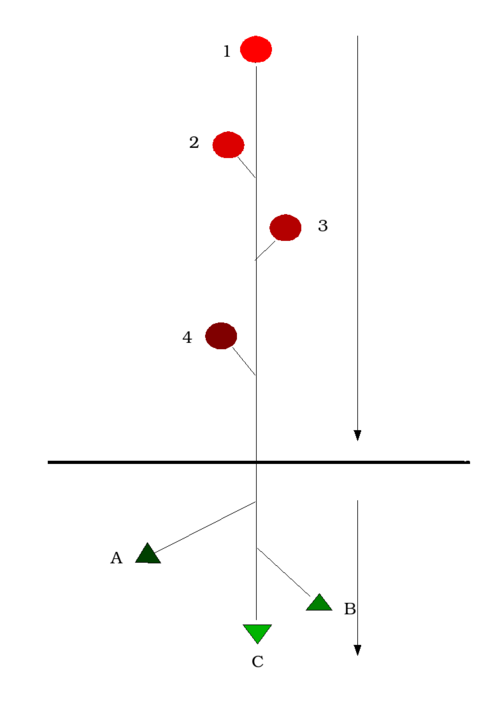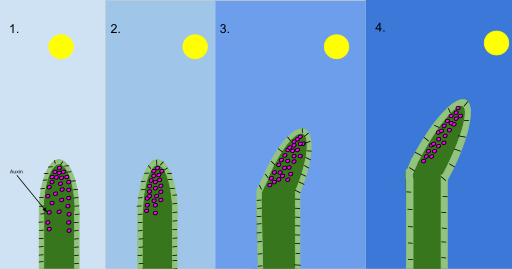OCR Specification focus:
‘Evaluate evidence for auxin’s role in apical dominance, including how auxin concentration affects lateral bud growth.’
Auxins are key plant hormones that regulate growth and development, particularly in controlling apical dominance—the inhibition of lateral bud growth by the plant’s main shoot apex. Their concentration gradients orchestrate plant architecture and responses to environmental stimuli.
Understanding Auxins
Auxins are a class of plant growth regulators primarily involved in cell elongation, apical dominance, root initiation, and tropic responses such as phototropism and geotropism.
Auxin: A group of plant hormones that promote cell elongation and regulate growth responses, notably indole-3-acetic acid (IAA).
Key Types of Auxins
Indole-3-acetic acid (IAA) – the principal naturally occurring auxin.
Synthetic auxins – such as 2,4-D (2,4-dichlorophenoxyacetic acid), used commercially as herbicides and rooting agents.
Auxins are synthesised mainly in shoot apical meristems, young leaves, and developing seeds. They are transported polar-wise, meaning directionally from the apex downward (basipetal transport).
Apical Dominance
Apical dominance is the process by which the main shoot apex suppresses the growth of lateral (axillary) buds, promoting vertical rather than bushy growth.
Apical dominance: The inhibition of lateral bud growth by the shoot apex, allowing the plant to grow upwards towards light.
Mechanism of Apical Dominance
The apical meristem of the shoot produces auxin (IAA), which diffuses downward through the phloem to the lateral buds and stem tissues. High auxin concentrations in these regions:
Suppress lateral bud outgrowth by preventing cell division and differentiation.
Promote cell elongation in the main stem, giving it growth priority.
Interact with other hormones such as cytokinins and abscisic acid, balancing overall growth.
When the apical bud is removed (a process known as decapitation), auxin levels in the stem drop sharply. This reduction lifts the suppression, allowing lateral buds to develop into new shoots.

Apical dominance arises because auxin from the shoot apex suppresses outgrowth of lower lateral buds. Inhibition is strongest nearest the apex and diminishes basipetally. Removing the apex lowers auxin and releases buds to grow. Source.
Hormonal Interactions in Apical Dominance
Apical dominance is not governed by auxin alone. It results from the interaction of multiple plant hormones that regulate each other’s effects.
Auxin–Cytokinin Relationship
Auxin produced in the shoot apex inhibits lateral bud growth.
Cytokinins, synthesised in the roots and transported upwards, stimulate bud growth.
The ratio of auxin to cytokinin determines whether a lateral bud remains dormant or begins to grow:
High auxin : cytokinin ratio → Bud inhibition
Low auxin : cytokinin ratio → Bud activation
Auxin–Gibberellin and Auxin–Abscisic Acid Interactions
Gibberellins (GAs) may promote stem elongation alongside auxin, amplifying vertical growth.
Abscisic acid (ABA) supports bud dormancy, reinforcing auxin’s inhibitory role.
These hormonal balances ensure that resources are directed primarily towards the main shoot under favourable conditions, maintaining a strong apical structure.
Experimental Evidence for Auxin’s Role
Early Studies
The classic experiments of Frits Went (1920s) and later Thimann and Skoog (1930s) established auxin’s function in apical dominance:
When the apical bud was removed, lateral buds began to grow.
Reapplying auxin paste to the cut surface restored dominance, inhibiting side shoot growth again.
This demonstrated that the presence of auxin, not just the physical bud, maintained inhibition of lateral buds.
Modern Evidence
Recent molecular studies have shown:
Auxin downregulates cytokinin biosynthesis genes, maintaining low cytokinin levels in lateral buds.
Auxin stimulates the production of strigolactones, another class of hormones that inhibit bud outgrowth.
These findings highlight auxin as a central regulator, influencing other hormonal pathways rather than acting alone.
Auxin Concentration Effects on Lateral Bud Growth
Concentration Gradient Significance
Auxin concentration affects plant growth differentially:
High concentrations at the apex → inhibit lateral buds, promote main stem elongation.
Moderate concentrations → may promote adventitious root formation.
Low concentrations → allow lateral buds to grow, increasing branching.
This dose-dependent effect arises because auxin controls the transcription of auxin response genes, altering the rate of cell elongation, division, and differentiation.
Local Redistribution
Light and gravity influence auxin distribution:
Phototropism: Auxin redistributes to the shaded side, elongating cells and causing the shoot to bend towards light.

In phototropism, auxin accumulates on the shaded side of the shoot, promoting cell elongation and bending toward light. This visual reinforces how auxin distribution can create local growth differences—a principle also underlying apical dominance. Extra detail: this diagram focuses on light responses rather than bud inhibition. Source.
Gravitropism: In roots, auxin accumulation on the lower side inhibits growth, bending roots downward.
These processes illustrate auxin’s mobility and context-specific actions, key for adapting plant architecture to environmental stimuli.
Investigating Apical Dominance
Experimental approaches to study auxin and apical dominance include:
Decapitation experiments – removing apical buds and observing lateral growth.
Auxin application – reapplying synthetic auxin to test inhibitory effects.
Hormone ratio analysis – quantifying auxin and cytokinin levels in stems and buds.
Genetic studies – using mutants defective in auxin transport (e.g., pin mutants) to observe altered branching patterns.
These studies confirm that auxin transport through polar auxin transport proteins (PIN proteins) is essential to maintaining apical dominance.
Commercial and Ecological Significance
Horticultural Applications
Understanding apical dominance enables manipulation of plant form:
Pruning removes the apical bud to encourage bushy growth in crops and ornamentals.
Auxin-based rooting powders stimulate root initiation in cuttings.
Selective auxin analogues serve as herbicides by inducing uncontrolled growth in weeds.
Ecological Advantage
Apical dominance allows plants to:
Maximise light capture in competitive environments.
Reduce self-shading and optimise photosynthesis.
Direct resources efficiently towards the main growing point during early development.
In summary, auxin is the primary hormonal regulator of apical dominance, acting through concentration gradients, interaction with other hormones, and gene regulation to coordinate plant form and adapt growth to environmental conditions.
FAQ
Apical dominance can be affected by environmental cues such as light intensity, day length, and nutrient availability.
Low light often reduces auxin production at the apex, weakening dominance and encouraging lateral growth. Conversely, high light levels enhance auxin synthesis, maintaining vertical growth.
Stress conditions such as drought or nutrient deficiency may also lower auxin levels, allowing the plant to produce more lateral branches to capture additional resources.
Strigolactones are signalling molecules that inhibit lateral bud growth. They are synthesised in roots and shoots, and their production is stimulated by auxin.
They act by:
Reducing the transport of auxin into lateral buds, limiting their activation.
Modifying gene expression in buds to maintain dormancy.
This interaction forms a feedback system where auxin indirectly reinforces its own inhibitory effect through strigolactone activity.
After decapitation, auxin levels drop unevenly along the stem, leading to variable bud activation.
The buds nearest the cut often grow first because they experience the most rapid decrease in auxin concentration.
Additionally, local cytokinin levels and vascular connections vary between buds, causing differences in resource supply and growth rate.
Auxin influences gene expression within lateral buds through auxin response factors (ARFs) and Aux/IAA proteins.
When auxin levels are high, ARFs bind to specific DNA sequences and activate genes that maintain dormancy.
When auxin levels drop, the repression lifts, allowing cytokinin-responsive genes to promote bud outgrowth.
This regulation ensures hormonal balance translates into precise developmental control.
Growers adjust apical dominance to achieve desirable plant forms and productivity.
Common methods include:
Pruning or pinching the shoot tip to stimulate bushier growth and increase flowering sites.
Applying synthetic auxins or inhibitors to control branching patterns.
Managing light exposure and fertiliser regimes to influence natural auxin gradients.
These practices balance vertical and lateral growth, optimising photosynthesis, fruiting, and overall plant structure.
Practice Questions
Question 1 (2 marks)
Describe how auxin produced at the shoot apex controls apical dominance in plants.
Mark Scheme:
1 mark: Auxin is produced in the shoot apical meristem and transported down the stem (basipetally).
1 mark: High auxin concentration inhibits lateral bud growth, maintaining apical dominance.
Question 2 (5 marks)
Explain how experiments have provided evidence for the role of auxin in apical dominance and how auxin interacts with other plant hormones to control lateral bud growth.
Mark Scheme:
1 mark: Decapitation experiments show that removing the apical bud causes lateral buds to grow, indicating that the apex releases an inhibitory substance.
1 mark: Applying synthetic auxin to the cut surface restores inhibition of lateral bud growth, demonstrating auxin’s role.
1 mark: Auxin interacts with cytokinins, which promote bud growth; a high auxin : cytokinin ratio maintains inhibition.
1 mark: Auxin stimulates strigolactone production, which further suppresses lateral bud outgrowth.
1 mark: These interactions ensure that resources are prioritised for main shoot elongation, maintaining apical dominance and efficient plant architecture.

